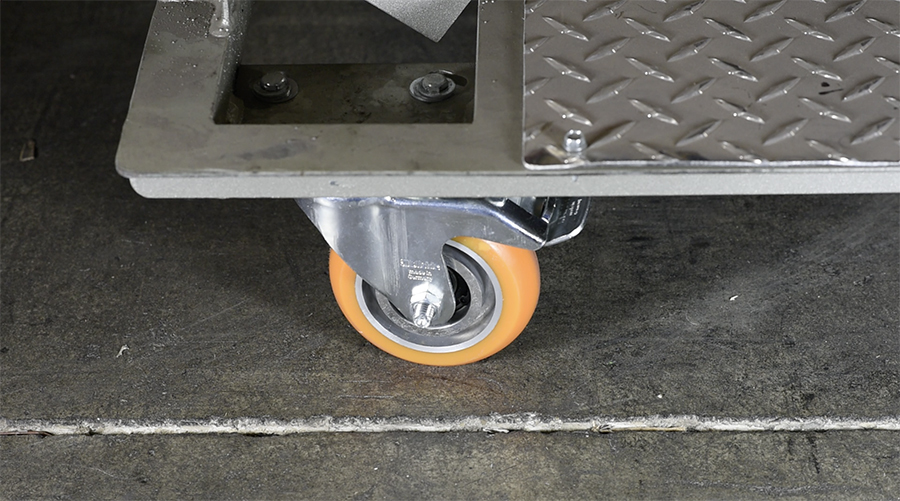Caster Total Lock Brakes Overview

Whether we’re talking about the foundation of a house or an offensive lineman, there are times when you gotta have stability. This applies to caster brakes as well. To get the most secure brake you can, you really need to consider a total lock brake because a total lock brake locks both the rig and the wheel itself. So, to make things easy, when you want little to no movement in your caster, and therefore your cart, total lock brakes are absolutely the way to go…in most cases.
TOTAL LOCK BRAKES: QUALITY AND APPLICATIONS
Unsurprisingly, total lock brakes are best for applications where you want a rock-solid cart setup. Total lock brakes allow you to secure your cart and use it as a workspace without any problem at all. Also, if carts are being transported from one factory to the next, total lock brakes are normally your best option, but remember your specific situation determines the solution. In fact, there are some important instances where you should actually go with a tech lock brake over a total lock brake. Just remember that a wide variety of factors determines which brakes, and casters in general, are right for your application.
In general, shoddy gear takes away time and money because we have downtime due to repairs and replacing. On the other hand, quality products save us time and money. Because there are so many casters on the market, you’re going to get some that just aren’t very good. So, how can we recognize quality with total lock brakes?

Some of the more common features of a poor-quality total lock are thin metal, lots of moving parts, and plastic in general. Quality is not just in the features but also integrated into the construction of the rig itself. The construction of the rig is itself tied to its design. For example, a rig that is designed around one piece of metal is a superior design because there are less points of failure. The durability and function of this type of brake is of the highest quality. Essentially, the design of total lock brakes really offers you both a measure of quality and unique options based on function, or in other words, what works for you and your unique situation.
OPTIONS BY DESIGN
The real strength of total lock brakes, besides being the most stable brake type, is the options and design features available to you. Like with tech lock brakes, a pedal is almost universally used to engage the brake. So, in many cases, you should compare the overall function and design of both tech lock and total lock brakes together. Give yourself the most options. You wouldn’t use a spoon for every meal; you would consider all utensils available for the job. No one wants to eat cereal with a fork. Choose the right brake for the job, whether tech lock or total lock, since each total lock brake has particular design features for specific situations.

The first main type is what might be referred to as a “standard” total lock brake. A good example is the Caster Connection total lock brake. With this type of brake, you have grooves that connect when you step on the brake. This engages the swivel head and stops it from rotating. At the same time, you have a pad putting pressure on the wheel that keeps the wheel from moving. This is, after all, why it’s called a total lock. This type of brake trails the wheel as you push or pull the cart, so you have to look for the brake pedal every time you stop or turn the cart. Also, the rig is often a kingpin rig, which is not recommended for towline applications, unless it is a forged kingpin system. Make sure you understand this when selecting brakes or discussing this with a caster expert. Learn more about different rig types here.
Another type, which is not as common, positions the brake pedal towards the front of the cart when you are pulling a cart or when it is in a towline. Blickle’s Stop-Top is the primary example. The actual mechanics and design of this particular total lock brake are very similar to the brakes referenced earlier. The main difference is the placement of the pedal. This pedal also lies virtually flush on the wheel, so there is less interference with your turning radius. This may be another instance where you might opt for this style of total lock brake, but make sure to check with an expert before you purchase these since they are unconventional in most cases.

Finally, the pinnacle of total lock brakes is the Ideal Stop brake from Blickle. This brake is the most unique total lock brake on the market. From the locking mechanism to the turning radius, the Ideal-Stop is innovative and practical.
There are two main ways that the brake and swivel are engaged; both rely on the wheel to provide tension. The first relies strictly on the tension of the wheel on the pad, which is a an industrial grade plastic. The tension of the wheel does not allow the caster to turn. There is no reliance on the grooves that you find in other total lock brakes.
The second version relies slightly on the tension of the wheel to push grooves together. This, like the previous total locks discussed, stops the caster from turning. At the same time, the brake mechanism connects with the wheel and stops it from moving. With both versions of the Ideal-Stop brake, you have a simple and reliable brake system that will not fail and that will last longer than other systems. By the way, simple is ideal, so this brake is aptly named.


